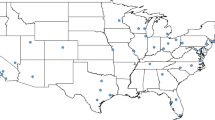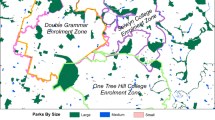Abstract
A neighborhood school policy is implemented in Beijing, where public education dominates. But only home owners, rather than renters are entitled to enroll in a local public school, even when both live in a school’s attendance zone. We estimate the implicit price of school quality in Beijing’s housing market by comparing within- and out-of-zone home values in adjacent buildings. Enabled by the “renter discrimination policy,” this study further controls for the difference in unobserved neighborhood traits using the rental differentials between paired observations. School quality has been capitalized in home values in Beijing. A within-zone housing unit is sold RMB 2,266 yuan per square meter more than if it were outside the attendance zone of a Key Primary School.


Similar content being viewed by others
Notes
The vast majority of children in Chinese cities go to public schools. Private schools are very small in number and often considered less attractive compared to good public schools.
An earlier remedy to school-induced sorting is to include neighborhood income and education as control variables on both sides of a boundary (e.g., Bayer et al., 2007). Unfortunately, by including demand variables like income and education, this approach introduces an endogeneity bias as households simultaneously select housing price and school quality, while both decisions are affected by income and education (Butler, 1982; Nguyen-Hoang and Yinger, 2011).
Identification of capitalization based on changes in school quality over time, however, may suffer from several issues. First, the lack of such variation in data, second, compared to cross-sectional studies, more serious downward bias due to the more significant role of measurement errors in school quality, and third, potential bias caused by time-varying unobservable factors (Nguyen-Hoang and Yinger, 2011).
According to the Beijing Municipal Commission of Education, there were only 24 private schools out of a total of 1,160 schools in Beijing. Those private schools are regarded as a different “animal” from public schools – private schools often place less emphasize on academic grades and frequently serve expats and households considering sending their children overseas for high school and/or college. See http://www.bjedu.gov.cn/publish/main/269/2010/20100120150130185385604/20100120150130185385604_.html and http://www.bjedu.gov.cn/publish/main/269/2010/20100120145833218227393/20100120145833218227393_.html.
Middle schools often enroll students outside of their attendance zones through a number of other procedures, such as admitting “especially talented” students, students from “Experimental Primary Schools (or Classes),” students whose parents’ employer is affiliated with the school in various ways, and students who pay a considerable amount of “extra admission fee.” The share of students enrolled in middle schools by attendance zone is less than 50 % in general and only about 10 % for good schools in Beijing, according to the 21st Century Education Research Institute.See http://finance.sina.com.cn/review/sbzt/20110901/165010418693.shtml.
Number obtained from the website of the Beijing Municipal Commission of Education.
Informal urban settlements, such as “urban villages”, are mainly occupied by rural migrants and temporal labor. Those communities are not eligible for public schools in most cities including Beijing.
See, e.g., http://www.ah.xinhuanet.com/news/2012-01/19/content_24574617.htm (“Over RMB 250,000 yuan Entrance Fee for Key Elementary School in Beijing - Competition of Parents to Obtain Admission,” Jan 19th, 2012), and http://www.bj.xinhuanet.com/bjpd_sdzx/2009-07/20/content_17147367.htm (“The unjustifiable allocation of educational resources lead to parents’ competition over within-zone housing,” July 20th,2009).
This group mainly comprises in-filled new residential estates that are not assigned to the Key Primary School yet, most likely due to the capacity limit of premium schools.
As the largest real estate information company in China, Soufun.com reports monthly and quarterly average first-sale prices (newly-built complexes sold by developers), resale prices (existing units sold by households) and rents (existing units leased by households) at the complex-level for a large number of residential complexes in Beijing.
The maximum within-pair distance of 0.75 km (2,461 ft) used by this study is a little over half of those adopted by most boundary fixed effect studies. According to Nguyen-Hoang and Yinger (2011), the maximum distance to the closest boundary adopted by most studies between 1999 and 2011 is 2,000 ft, indicating a 4,000 f. inter-property maximum distance. We believe our choice of shorter maximum inter-property distance is necessary given the much higher density of Beijing.
We choose to not use logarithm of D_CENTER since we believe D_CENTER indicates accessibility at the metro area level instead of local level, the pattern of distance gradient would be different from distances to local (dis)amenities such as subway stations and hospitals. Nevertheless, we have also tested by using the logarithm of D_CENTER in our regressions. The results are very similar to those reported in the paper.
We acknowledge that the spatial proximity to a nearby good school is also preferred by a renter if he/she has a child and already obtains the right of school attendance through other means (for instance, pay the very high school attendance fee) rather than buying a within-school housing unit. We address this concern by including ln(D_SCHOOL) in the price/rent regressions as a control variable.
Hu et al. (2014) use a model similar to Equation (3) to infer the home value premium of education quality. As discussed earlier, they do not include rent differential as an explanatory variable in the price differential equation. So their work fails to control for the omitted neighborhood attributes due to school quality-related residential sorting, which are captured by rent differentials in this study.
We thank an anonymous referee for pointing this out.
References
Bayer, P., Ferreira, F., & McMillan, R. (2007). A Unified Framework for Measuring Preferences for Schools and Neighborhoods. NBER Working Paper,No.13236.
Black, S. E. (1999). Do Better Schools Matter? Parental Valuation of Elementary Education. The Quarterly Journal of Economics, 114(2), 577–599.
Butler, R. V. (1982). The specification of hedonic indexes for urban housing. Land Economics, 58(1), 96–108.
Cheshire, P., & Sheppard, S. (2004). Capitalising the value of free schools: the impact of supply characteristics and uncertainty. Economic Journal, 114(499), 397–424.
Fack, G., & Grenet, J. (2010). When do better schools raise housing prices? Evidence from Paris public and private schools. Journal of Public Economics, 94(1), 59–77.
Feng, H., & Lu, M. (2010). School quality and housing prices: Empirical evidence based on a natural experiment in Shanghai, China. The Journal of World Economy, 12, 89–104 (in Chinese).
Figlio, D. N., & Lucas, M. E. (2004). What’s in a grade? School report cards and the housing market. American Economic Review, 94(3), 591–604.
Gibbons, S., & Machin, S. (2006). Paying for primary schools: admission constraints, school popularity or congestion? Economic Journal, 116(510), 77–92.
Gibbons, S., Machin, S., & Silva, O. (2013). Valuing school quality using boundary discontinuities. Journal of Urban Economics, 75, 15–28.
Hu, W., Zheng, S., & Wang, R. (2014). The capitalization of school quality in home value: A matching regression approach with housing price-rent comparison. China Economic Quarterly, 13(3), 1195–1214 (in Chinese).
Judd, G. D., & Watts, J. M. (1981). Schools and housing values. Land Economics, 57, 459–470.
Kane, T. J., Riegg, S. K., & Staiger, D. O. (2006). School quality, neighborhoods, and housing prices. American Law and Economics Review, 8(2), 183–212.
Nguyen-Hoang, P., & Yinger, J. (2011). The capitalization of school quality into house values. A Review Journal of Housing Economics, 20, 30–48.
Oates, W. E. (1969). The effects of property taxes and local public spending on property values: an empirical study of tax capitalization and the Tiebout hypothesis. Journal of Political Economy, 77(6), 957–971.
Reback, R. (2005). House prices and the provision of local public services: capitalization under school choice programs. Journal of Urban Economics, 57(2), 275–301.
Ries, J., & Somerville, T. (2010). School quality and residential values: evidence from Vancouver zoning. Review of Economics and Statistics, 92(4), 928–944.
Rosen, H. S., & Fullerton, D. J. (1977). A not on local tax rates, public benefit levels and property values. Journal of Political Economy, 85(2), 433–440.
Rosenthal, L. (2003). The value of secondary school quality. Oxford Bulletin of Economics and Statistics, 65(3), 329–355.
Zahirovic-Herbert, V., & Turnbull, G. (2009). Public school reform, expectations, and capitalization: what signals quality to homebuyers? Southern Economic Journal, 75(4), 1094–1113.
Zheng, S., Fu, Y., & Liu, H. (2006) Housing-choice hindrances and urban spatial structure: evidence from matched location and location-preference data in Chinese cities. Journal of Urban Economics, 60, 535–557.
Zheng, S., & Kahn, M. E. (2008). Land and residential property markets in a booming economy: New evidence from Beijing. Journal of Urban Economics, 63, 743–757.
Acknowledgements
We thank the National Natural Science Foundation of China (No. 71273154 and No. 71322307) and the Program for New Century Excellent Talents in University (NCET-12-0313) for research support.
Author information
Authors and Affiliations
Corresponding author
Rights and permissions
About this article
Cite this article
Zheng, S., Hu, W. & Wang, R. How Much Is a Good School Worth in Beijing? Identifying Price Premium with Paired Resale and Rental Data. J Real Estate Finan Econ 53, 184–199 (2016). https://doi.org/10.1007/s11146-015-9513-4
Published:
Issue Date:
DOI: https://doi.org/10.1007/s11146-015-9513-4




